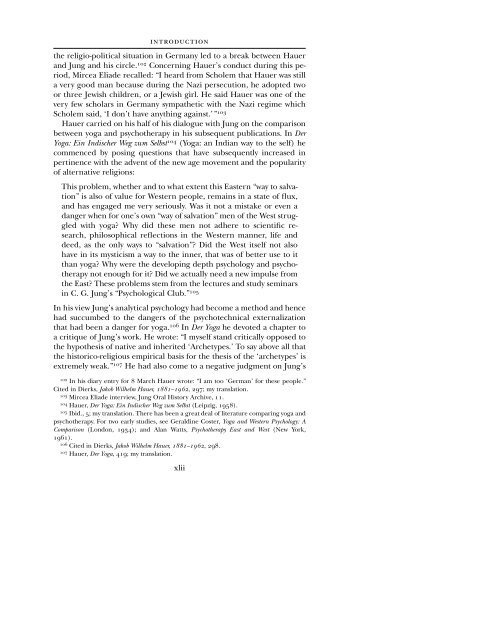CG JUNG - Countryside Anarchist
CG JUNG - Countryside Anarchist
CG JUNG - Countryside Anarchist
You also want an ePaper? Increase the reach of your titles
YUMPU automatically turns print PDFs into web optimized ePapers that Google loves.
INTRODUCTION<br />
the religio-political situation in Germany led to a break between Hauer<br />
and Jung and his circle. 102 Concerning Hauer’s conduct during this period,<br />
Mircea Eliade recalled: “I heard from Scholem that Hauer was still<br />
a very good man because during the Nazi persecution, he adopted two<br />
or three Jewish children, or a Jewish girl. He said Hauer was one of the<br />
very few scholars in Germany sympathetic with the Nazi regime which<br />
Scholem said, ‘I don’t have anything against.’” 103<br />
Hauer carried on his half of his dialogue with Jung on the comparison<br />
between yoga and psychotherapy in his subsequent publications. In Der<br />
Yoga: Ein Indischer Weg zum Selbst 104 (Yoga: an Indian way to the self) he<br />
commenced by posing questions that have subsequently increased in<br />
pertinence with the advent of the new age movement and the popularity<br />
of alternative religions:<br />
This problem, whether and to what extent this Eastern “way to salvation”<br />
is also of value for Western people, remains in a state of flux,<br />
and has engaged me very seriously. Was it not a mistake or even a<br />
danger when for one’s own “way of salvation” men of the West struggled<br />
with yoga? Why did these men not adhere to scientific research,<br />
philosophical reflections in the Western manner, life and<br />
deed, as the only ways to “salvation”? Did the West itself not also<br />
have in its mysticism a way to the inner, that was of better use to it<br />
than yoga? Why were the developing depth psychology and psychotherapy<br />
not enough for it? Did we actually need a new impulse from<br />
the East? These problems stem from the lectures and study seminars<br />
in C. G. Jung’s “Psychological Club.” 105<br />
In his view Jung’s analytical psychology had become a method and hence<br />
had succumbed to the dangers of the psychotechnical externalization<br />
that had been a danger for yoga. 106 In Der Yoga he devoted a chapter to<br />
a critique of Jung’s work. He wrote: “I myself stand critically opposed to<br />
the hypothesis of native and inherited ‘Archetypes.’ To say above all that<br />
the historico-religious empirical basis for the thesis of the ‘archetypes’ is<br />
extremely weak.” 107 He had also come to a negative judgment on Jung’s<br />
102 In his diary entry for 8 March Hauer wrote: “I am too ‘German’ for these people.”<br />
Cited in Dierks, Jakob Wilhelm Hauer, 1881–1962, 297; my translation.<br />
103 Mircea Eliade interview, Jung Oral History Archive, 11.<br />
104 Hauer, Der Yoga: Ein Indischer Weg zum Selbst (Leipzig, 1958).<br />
105 Ibid., 5; my translation. There has been a great deal of literature comparing yoga and<br />
psychotherapy. For two early studies, see Geraldine Coster, Yoga and Western Psychology: A<br />
Comparison (London, 1934); and Alan Watts, Psychotherapy East and West (New York,<br />
1961).<br />
106 Cited in Dierks, Jakob Wilhelm Hauer, 1881–1962, 298.<br />
107 Hauer, Der Yoga, 419; my translation.<br />
xlii


